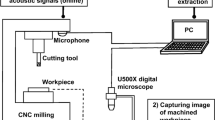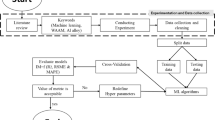Abstract
The quick development of mass customization in the apparel industry leads to an exponential increase of garment size combinations for markers, which induces a heavy and complex workload of marker making. In this context, due to the complexity of the problem, the classical marker making methods using the existing commercialized software are less performant in terms of efficiency and accuracy. Therefore, machine learning techniques, usually taken as efficient tools for extracting relevant information from data measured in uncertain and complex scenarios, are considered much simpler and faster. In this study, we apply the methods of multiple linear regression (MLR) and radial basis function neural network (RBF NN) to estimate marker lengths that are used in various garment production modes by considering various sets of garment sizes and different marker types. The experimental results show that the proposed approach leads to a good performance in estimating marker lengths of different types of markers (mixed marker and group marker) with diverse size combinations taken from various sets of garment sizes in both mass production and mass customization conditions.














Similar content being viewed by others
Data availability
Data associated with this study is recorded.
References
Nayak R & Padhye R (Eds.). (2015). Garment manufacturing technology. Elsevier.
Naveed T, Hussain A, Zhong Y (2018) Reducing fabric wastage through image projected virtual marker (IPVM). Text Res J 88(14):1571–1580
Thomassey S, Zeng X (eds) (2018) Artificial intelligence for fashion industry in the big data era. Springer, Singapore
Fowler RJ, Paterson MS, Tanimoto SL (1981) Optimal packing and covering in the plane are NP-complete. Inf Process Lett 12(3):133–137
Heckmann R, Lengauer T (1995) A simulated annealing approach to the nesting problem in the textile manufacturing industry. Ann Oper Res 57(1):103–133
Jacobs-Blecha C, Ammons JC, Schutte A, Smith T (1997) Cut order planning for apparel manufacturing. IIE Trans 30(1):79–90
Xu Y, Thomassey S, & Zeng X (2020) Optimization of garment sizing and cutting order planning in the context of mass customization. Int J Adv Manuf Technol, 1-19.
Jaidormrong, J., Chaiyaratana, N., & Hassamontr, J. (2003). Software tool development for marker making operations in textile industry. In Proceedings 2003 IEEE International Symposium on Computational Intelligence in Robotics and Automation. Computational Intelligence in Robotics and Automation for the New Millennium (Cat. No. 03EX694) (Vol. 2, pp. 503-508). IEEE.
Amaral C, Bernardo J, Jorge J (1990) Marker-making using automatic placement of irregular shapes for the garment industry. Comput Graph 14(1):41–46
Hwan Sul I, ** Kang T (2002) Optimal marking of garment patterns using rectilinear polygon approximation. Int J Cloth Sci Technol 14(5):334–346
Yeung LHW, Tang WKS (2003) A hybrid genetic approach for garment cutting in the clothing industry. IEEE Trans Ind Electron 50(3):449–455
Wong WK, Leung SS (2009) A hybrid planning process for improving fabric utilization. Text Res J 79(18):1680–1695
Wong WK, Wang XX, Mok PY, Leung SYS, Kwong CK (2009) Solving the two-dimensional irregular objects allocation problems by using a two-stage packing approach. Expert Syst Appl 36(2):3489–3496
Wong WK, Guo ZX (2010) A hybrid approach for packing irregular patterns using evolutionary strategies and neural network. Int J Prod Res 48(20):6061–6084
Ko E, Kim S (2013) Garment pattern nesting using image analysis and three-dimensional simulation. Fibers Polymers 14(5):860–865. https://doi.org/10.1007/s12221-013-0860-6
Heckmann R, Lengauer T (1998) Computing closely matching upper and lower bounds on textile nesting problems. Eur J Oper Res 108(3):473–489
Awais A, Naveed A (2015) Width-packing heuristic for grou** in two-dimensional irregular shapes cutting stock problem. Arab J Sci Eng 40(3):799–816
Javanshir H, Rezaei S, Najar SS, Ganji SS (2010) Two dimensional cutting stock management in fabric industries and optimizing the large object’s length. Int J Res Rev Appl Sci 4(2)
Bounsaythip, C., & Maouche, S. (1997, October). Irregular shape nesting and placing with evolutionary approach. In 1997 IEEE International Conference on Systems, Man, and Cybernetics. Computational Cybernetics and Simulation (Vol. 4, pp. 3425-3430). IEEE.
Vorasitchai S, Madarasmi S (2003) Improvements on layout of garment patterns for efficient fabric consumption. In Proceedings of the 2003 International Symposium on Circuits and Systems, 2003. ISCAS'03. (Vol. 4, pp. IV-IV). IEEE. https://doi.org/10.1109/iscas.2003.1206139
Vilumsone-Nemes I (2018) Industrial cutting of textile materials. Woodhead Publishing.
Haque MN (2016) Impact of different sorts of market efficiency in fabric consumption. Int J Text Sci 5(5):96–109
Abd Jelil R (2018) Review of artificial intelligence applications in garment manufacturing. In Artificial Intelligence for Fashion Industry in the Big Data Era (pp. 97-123). Springer, Singapore
Thomassey S, Happiette M (2007) A neural clustering and classification system for sales forecasting of new apparel items. Appl Soft Comput 7(4):1177–1187
Ferreira KJ, Lee BHA, Simchi-Levi D (2016) Analytics for an online retailer: Demand forecasting and price optimization. Manuf Serv Oper Manag 18(1):69–88
Huang H, Liu Q (2017) Intelligent retail forecasting system for new clothing products considering stock-out. Fibres Text East Eur 25:10–16
Lin TH (2004) Construction of Predictive Model on Fabric and Sewing Thread Optimization. J Text Eng 50(1):6–11
Jaouadi M, Msahli S, Babay A, Zitouni B (2006) Analysis of the modeling methodologies for predicting the sewing thread consumption. Int J Cloth Sci Technol 18(1):7–18
Hui CL, Ng SF (2005) A new approach for prediction of sewing performance of fabrics in apparel manufacturing using artificial neural networks. J Text Inst 96(6):401–405
Hui CL, Ng SF (2009) Predicting seam performance of commercial woven fabrics using multiple logarithm regression and artificial neural networks. Text Res J 79(18):1649–1657
Pavlinic DZ, Gersak J, Demsar J, Bratko I (2006) Predicting seam appearance quality. Text Res J 76(3):235–242
Pavlinic DZ, Gersak J (2009) Predicting garment appearance quality. Open Text J 2(1):29–38
Hui PCL, Chan KCC, Yeung KW, Ng FSF (2007) Application of artificial neural networks to the prediction of sewing performance of fabrics. Int J Cloth Sci Technol 19(5):291–318
Zhang X, & Wong LY (2014) Virtual fitting: real-time garment simulation for online shop**. In SIGGRAPH Posters (pp. 41-1).
Liu K, Zeng X, Bruniaux P, Wang J, Kamalha E, Tao X (2017) Fit evaluation of virtual garment try-on by learning from digital pressure data. Knowl-Based Syst 133:174–182
Foysal KH, Chang HJ, Bruess F, Chong JW (2021) SmartFit: smartphone application for garment fit detection. Electronics 10(1):97
Al-Rashidi K, Alazmi R, Alazmi M (2015) Artificial neural network estimation of thermal insulation value of children’s school wear in Kuwait classroom. Adv Artif Neural Syst 2015:1–9
Salamone F, Belussi L, Currò C, Danza L, Ghellere M, Guazzi G, Lenzi B, Megale V, Meroni I (2018) Integrated method for personal thermal comfort assessment and optimization through users’ feedback, IoT and machine learning: a case study. Sensors 18(5):1602
Koustoumpardis PN, Aspragathos NA (2014) Intelligent hierarchical robot control for sewing fabrics. Robot Comput Integr Manuf 30(1):34–46
Ramisa A, Alenya G, Moreno-Noguer F, Torras C (2014) Learning RGB-D descriptors of garment parts for informed robot gras**. Eng Appl Artif Intell 35:246–258
Degraeve Z, Gochet W, Jans R (2002) Alternative formulations for a layout problem in the fashion industry. Eur J Oper Res 143(1):80–93
Murray AF (ed) (1995) Applications of neural networks (pp. 157-189). Kluwer Academic Publishers, The Netherlands
Mujtaba IM (2001) Application of neural networks and other learning technologies in process engineering. World Scientific
Cheng CB, Lee ES (2001) Fuzzy regression with radial basis function network. Fuzzy Sets Syst 119(2):291–301
Diamantidis NA, Karlis D, Giakoumakis EA (2000) Unsupervised stratification of cross-validation for accuracy estimation. Artif Intell 116(1-2):1–16 Abd Jelil, R. (2018)
Acknowledgements
Thanks to Dr **ang YAN for valuable editorial comments and suggestions.
Funding
Thanks to the Chinese Scholarship Council (CSC) and Zhejiang Sci-Tech University for the financial support of this research.
Author information
Authors and Affiliations
Contributions
Conceptualization, Yanni Xu and Sébastien Thomassey; investigation, Yanni Xu; data collection and curation, Yanni Xu; writing—original draft preparation, Yanni Xu; writing—review and editing, Sébastien Thomassey and **anyi Zeng; supervision, Sébastien Thomassey and **anyi Zeng.
Corresponding author
Ethics declarations
Ethics approval
Not applicable.
Consent to participate
The authors confirm that the manuscript has been read and approved by all named authors.
Consent for publication
All the authors have reached agreement for publication in The International Journal of Advanced Manufacturing Technology.
Competing interests
The authors declare no competing interests.
Additional information
Publisher’s note
Springer Nature remains neutral with regard to jurisdictional claims in published maps and institutional affiliations.
Rights and permissions
About this article
Cite this article
Xu, Y., Thomassey, S. & Zeng, X. Machine learning-based marker length estimation for garment mass customization. Int J Adv Manuf Technol 113, 3361–3376 (2021). https://doi.org/10.1007/s00170-021-06833-w
Received:
Accepted:
Published:
Issue Date:
DOI: https://doi.org/10.1007/s00170-021-06833-w




